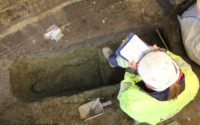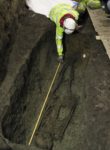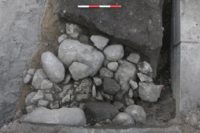 Last December, archaeologists began a secret excavation under City Hall Square in the heart of Copenhagen. It was kept scrupulously under wraps until February to give the team the opportunity to excavate what is thought to be the oldest burial ground in Copenhagen without risking contamination of the site by curious onlookers. Between December and the end of February, the remains of 20 men, women and children who lived around 1,000 years ago were unearthed just three feet under Denmark’s busiest square.
Last December, archaeologists began a secret excavation under City Hall Square in the heart of Copenhagen. It was kept scrupulously under wraps until February to give the team the opportunity to excavate what is thought to be the oldest burial ground in Copenhagen without risking contamination of the site by curious onlookers. Between December and the end of February, the remains of 20 men, women and children who lived around 1,000 years ago were unearthed just three feet under Denmark’s busiest square.
This is a highly significant find because by the known chronology, these individuals were the first Copenhagers, and archaeologists believe there are even more human remains to be found, at least another two layers of burials underneath the 20 already excavated. Since February, another 10 skeletons have been discovered. These 30 skeletons predate the legendary founding of the city by Bishop Absalon, who was said to have been given the site as a gift from King Valdemar in the 1160s, by at least a century, and upends the received wisdom that before Absalon built his castle Copenhagen was just a sleepy fishing village under the shadow of the neighboring urban center of Roskilde.
 The human remains are now at the Faculty of Health and Medical Sciences at the University of Copenhagen where they are undergoing further tests, including DNA analysis. Once the testing is done, they will be studied in more depth at the Natural History Museum of Denmark. This research will rewrite the history of Copenhagen’s earliest days, replacing the founding myth with a whole different category of information grounded in the biological data of the first residents of what would become Denmark’s capital city.
The human remains are now at the Faculty of Health and Medical Sciences at the University of Copenhagen where they are undergoing further tests, including DNA analysis. Once the testing is done, they will be studied in more depth at the Natural History Museum of Denmark. This research will rewrite the history of Copenhagen’s earliest days, replacing the founding myth with a whole different category of information grounded in the biological data of the first residents of what would become Denmark’s capital city.
 Meanwhile, the excavation at City Hall Square continues and has now added structural evidence to the new history of Copenhagen’s founding. Archaeologists have unearthed a stone foundation that they think belonged to the first church built in the city.
Meanwhile, the excavation at City Hall Square continues and has now added structural evidence to the new history of Copenhagen’s founding. Archaeologists have unearthed a stone foundation that they think belonged to the first church built in the city.
“If it is a church, it would further prove that Copenhagen was an established city at the start of the Middle Ages,” Lars Ewald Jensen, the archaeological head of the Museum of Copenhagen, told Videnskab.dk.
“You can have a burial site without an established city, because there needs to be more elements present before one can call it a city. But then again, you can’t have a city without having a church.” […]
The stone foundation bears witness to either a church being at the location at some point or a dyke that has split the graveyard into two sections.
“We hope we have discovered the foundation of a church building, in which case it would be a church that co-existed with St Clemens Church, which was excavated in 2008, or is older. Potentially, we have discovered the oldest church in Copenhagen,” Stine Damsbo Winther, an archaeologist with the Museum of Copenhagen, told Videnskab.dk.
The bodies have to go, they have paid no rent for a central city location for a thousand years 😉
It would be interesting if there are people living in the city today who are descendants of the cemetery occupants.
Yes indeed, but the “Middle Ages”, as we know, where kicked off already in 476AD, when the “Western Augustulus” was forced to hand it all over to Odoacer, at least what is now Italy. Are those bones from pre-830 (unlikely), 986AD (“Bluetooth”!), or possibly later?:
—————
Charlemagne converted the Saxons ‘cum ferro ignique’ :skull: , while for Scandinavia -instead of an outright invasion- St. Ansgar (801 – 865AD) was playing a certain role. King Gudfred was apparently murdered by a nephew of his in 810AD (“Godofrido Danorum rege mortuo Hemmingus filius fratris eius in regnum successit ac pacem cum imperatore fecit.”), who -in 812- was initially followed by Harald ‘Klak’ Halfdansson and his brother Ragnfrid (“Harioldus et Reginfridus reges Danorum missa ad imperatorem legatione pacem petunt.”, yet another brother was “Anulo”), but the ‘struggle for succession’ seems to have been a rather constant one.
From 813 onwards, they had to fight off the sons of Gudfred -apparently cousins of theirs- and the Obotrites had been likewise a threat. Charlemagne died in 814, and he might have considered this phase some sort of Danish ‘proxy war’, as he had been providing shelter and alliances to other rulers before. The 815 entries of the Frankish Annals focus on the campaign for restoring Harald to his throne. “The emperor [now Louis the Pious] commanded that Saxons and Obodrites should prepare for this campaign, and twice in that winter the attempt was made to cross the Elbe, but this was apparently followed no longer.
A next attempt in 819, again with help from the Obotrites, met with more success. In 821 some kind of settlement seems to have been reached. An 826 entry, however, reads “At the same time Harald came with his wife and a great number of Danes and was baptized with his companions at St. Alban’s in Mainz (“Eodem tempore Herioldus cum uxore et magna Danorum multitudine veniens Mogontiaci apud sanctum Albanum cum his, quos secum adduxit, baptizatus est”), and he returned to Denmark with Ansgar and other Franks. However, Harald disappears from Frankish sources by the late 820s. Thus, he had certainly failed to regain his throne.
:hattip:
Gosh, I need to stop here! – This ‘Bishop Absalon’, who is said to have founded Copenhagen, apparently initiated a twenty year crusade from there against the Wends in 1164AD, and on Rügen (the island from yesterday’s post), the Wendish fortress at Arkona, containing the sanctuary of their god Svantevit, was laid under siege and conquered in 1168 (i.e. the Slavic cult site of ‘Jaromarsburg’).
Also -what I knew before- one of my classmates is of ‘nobility’ that originated in Rügen (since 1290/ 1316AD, possibly invested by Vitslav II, Prince of Rügen?). From Arkona, however, Bishop Absalon proceeded by sea to the ringwall ‘Charenza’ (with unexpected similarities to myself) in central Rügen, i.e. he took more or less the route that the fleeing king ‘Bluetooth’ might have taken in 986.
Charenza was assumed to have been at 54° 18′ 51″ N, 13° 20′ 50″ E – but the spot at 54° 30′ 7″ N, 13° 19′ 0″ E seems more likely, i.e. 8km to the East from where yesterday’s silver hoard was found. The golden ‘hiddensee treasure’ was found 4km to the West (on Hiddensee island, of course). My own family seems to be from the Baltic, and -similar to Harald (the older one)- they all later ended up in Franconia.
———————————–
Turns out, I really need to stop: An undetonated 500kg shell was found over here (300m away), and we are evacuated on Friday – Stupid History, that! :ohnoes: